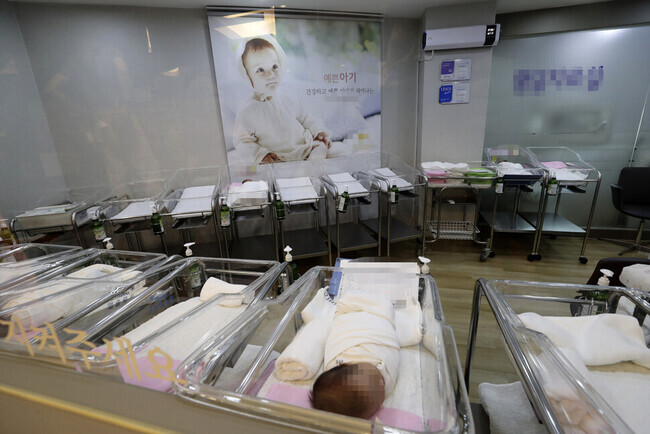hankyoreh
Links to other country sites 다른 나라 사이트 링크
In Korea, fewer marriages mean fewer newlyweds are having fewer kids

The number of South Korean newlyweds narrowly topped 1 million, while the percentage without children reached a historic high, statistics show. The figures illustrate a situation where the already severe low birth rate issue has gotten worse over time.
According to 2022 figures on newly married couples released by Statistics Korea on Monday, a total of 1.032 million couples in South Korea were counted as “newly married” as of Nov. 1 of last year, down by 69,000 (6.3%) from a year before.
A “newly married couple” is defined as a couple who reported their marriage less than five years earlier and continues to live in a marital relationship in South Korea.
Related statistics were first tallied in 2015, when the number of couples stood at 1.472 million. Since then, the total has continued its downward trend to reach a new historic low each year. The 2023 total is seen as likely to come in under 1 million couples.
Statistics Korea said the decline in the number of couples married for five years or less reflected the “influence of a decline in the number of marriages.”
According to the agency’s population trend report, the annual number of marriages in South Korea plunged from 264,000 in 2017 to an all-time low of 192,000 last year. The number of first marriages was down by 56,000, while the number of remarriages fell by 13,000.
Between 2015 and 2022, the percentage of couples marrying for the first time dropped from 80.1% of all married couples to 79.0%.
Among first-time newly married couples, the percentage with at least one child was 53.6%, down by 0.6 percentage points from the year before. The remaining 46.4% had no children, up by 0.6 percentage points to an all-time high.
The average number of children per first-time married couple also dropped by 0.01 from a year earlier to reach a record low of 0.65.
The proportion of first-time newly married couples with both spouses working stood at 57.2% last year, an increase of 2.3 percentage points compared with 2021. The annual income for newly married couples averaged 67.9 million won (US$51,600), up by 6.1% from the year before.
The statistics show that the rise in dual-income households has led to an increase in “DINKs” with large combined incomes but no children.
Among dual-income first-time married couples, 50.2% had no children, an increase of 8.1 percentage points from 42.1% in 2015. The percentage of dual-income couples with no children was 9.6 percentage points higher than the 40.6% of single-income couples who had no children as of last year.
The statistics showed 89.0% of newly married couples having at least one loan from a financial business, including both bank and non-bank financial institutions. The median loan balance was 164.17 million won, up by 11.17 million won (7.3%) from the year before.
But the rate of increase in the loan balance was also down by more than half from the 15.4% recorded in 2021. Statistics Korea explained that this “appeared to reflect the influence of the growing interest burden associated with rising interest rates.”
The proportion of newly married couples who owned a home was 40.5% last year, a decrease of 1.5 percentage points. This was interpreted as signaling that high interest rates have led many to opt for rental and key deposit arrangements rather than incurring debt with banks to purchase their own residence.
Among couples who did own a residence, 59.6% also had children, a 10.1-percentage point higher rate than among couples who did not own a residence. The home-owning couples also had an average of 0.72 children, or 0.13 more than non-home-owning couples.
By Park Jong-o, staff reporter
Please direct questions or comments to [english@hani.co.kr]

Editorial・opinion
![[Column] Samsung’s ‘lost decade’ and Lee Jae-yong’s mismatched chopsticks [Column] Samsung’s ‘lost decade’ and Lee Jae-yong’s mismatched chopsticks](https://flexible.img.hani.co.kr/flexible/normal/500/300/imgdb/original/2024/0512/3017154788490114.jpg) [Column] Samsung’s ‘lost decade’ and Lee Jae-yong’s mismatched chopsticks
[Column] Samsung’s ‘lost decade’ and Lee Jae-yong’s mismatched chopsticks![[Correspondent’s column] The real reason the US is worried about Chinese ‘overcapacity’ [Correspondent’s column] The real reason the US is worried about Chinese ‘overcapacity’](https://flexible.img.hani.co.kr/flexible/normal/500/300/imgdb/original/2024/0510/5217153290112576.jpg) [Correspondent’s column] The real reason the US is worried about Chinese ‘overcapacity’
[Correspondent’s column] The real reason the US is worried about Chinese ‘overcapacity’- [Editorial] Yoon’s gesture at communication only highlights his reluctance to change
- [Editorial] Perilous stakes of Trump’s rhetoric around US troop pullout from Korea
- [Guest essay] Preventing Korean Peninsula from becoming front line of new cold war
- [Column] The state is back — but is it in business?
- [Column] Life on our Trisolaris
- [Editorial] Penalties for airing allegations against Korea’s first lady endanger free press
- [Editorial] Yoon must halt procurement of SM-3 interceptor missiles
- [Guest essay] Maybe Korea’s rapid population decline is an opportunity, not a crisis
Most viewed articles
- 1Seoul’s plan to adopt SM-3 missiles is like wanting a sledgehammer to catch a fly
- 2[Column] Samsung’s ‘lost decade’ and Lee Jae-yong’s mismatched chopsticks
- 3[Correspondent’s column] The real reason the US is worried about Chinese ‘overcapacity’
- 4Korea poised to overtake Taiwan as world’s No. 2 chip producer by 2032
- 560% of young Koreans see no need to have kids after marriage
- 6[Editorial] Yoon’s gesture at communication only highlights his reluctance to change
- 7Yoon voices ‘trust’ in Japanese counterpart, says alliance with US won’t change
- 8Yoon rejects calls for special counsel probes into Marine’s death, first lady in long-awaited presse
- 9S.K.-Japan joint history project to be revived
- 10Former President Roh Tae-woo, mastermind of 1979 military coup, dies at 88